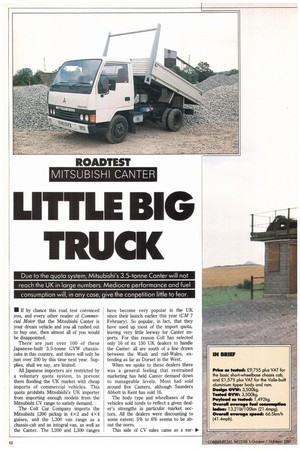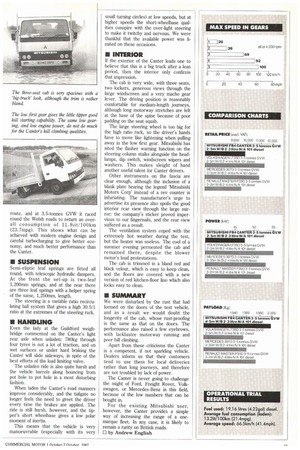LITTLE BIG TRUCK
Page 64

Page 66

Page 67

If you've noticed an error in this article please click here to report it so we can fix it.
Due to the quota system, Mitsubishi's 3.5-tonne Canter will not reach the UK in large numbers. Mediocre performance and fuel consumption will, in any case, give the conpetition little to fear.
• If by chance this road test convinced you, and every other reader of Commercial Motor that the Mitsubishi Canter is your dream vehicle and you all rushed out to buy one, then almost all of you would be disappointed.
There are just over 100 of these Japanese-built 3.5-tonne GVW chassiscabs in this country, and there will only be just over 200 by this time next year. Supplies, shall we say, are limited.
All Japanese importers are restricted by a voluntary quota system, to prevent them flooding the UK market with cheap imports of commercial vehicles. This quota prohibits Mitsubishi's UK importer from importing enough models from the Mitsubishi CV range to satisfy demand.
The Colt Car Company imports the Mitsubishi 1200 pickup in 4x2 and 4x4 guises, and the L300 van range as a chassis-cab and an integral van, as well as the Canter. The L200 and L300 ranges have become very popular in the UK since their launch earlier this year (CM 7 February). So popular, in fact, that they have used up most of the import quota, leaving very little leeway for Canter imports. For this reason Colt has selected only 16 of its 150 UK dealers to handle the Canter: all are south of a line drawn between the Wash and mid-Wales, extending as far as Dorset in the West.
When we spoke to these dealers there was a general feeling that restrained marketing has held Canter demand down to manageable levels. Most had sold around five Canters, although Saunders Abbott in Kent has sold 16.
The body type and wheelbases of the vehides sold tends to reflect a given dealer's strengths in particular market sectors. All the dealers were discounting to some extent; 5% to 6% seems to be about the norm.
This side of CV sales came as a cur prise to a number of the dealers we spoke to who were new to the 3.5-tonne market and the discounting tactics of the larger manufacturers that operate within it.
Although Colt is under the impression that a number of Canter customers are existing Mitsubishi owners looking for greater weight capacity, we found that many customers are new Mitsubishi owners attracted by the Mitsubishi warranty, or the 'big truck' look of the cab.
• BODYWORK
It is true that the Canter's three-seater cab gives it a large frontage, but a walk round the side reveals that this is a lorry that does not eat its crusts. The shortwheel-base tipper version that we tested is fitted with the little aluminium alloy Valle-built tipper body, and the combination of the large cab and low body looks slightly ridiculous.
The cab is unique in its class in being tiltable, and in proper big-truck fashion. Interlocks mean that the cab cannot be inadvertently left unsecured or inadvertently lowered. The cab is a fairly light structure anyway, but is counterbalanced to make lifting it a simple one-man task. Unusually on a tilt-cab vehicle, the brake and clutch master-cylinders are mounted rigidly on the chassis, and connected to their pedals via articulated links.
All the details on the sides of the cab are scaled down from a larger lorry: The air filter stack, the cab door air deflectors and the large mirror brackets all look like HO scale replicas.
Unfortunately, that 'authentic' look does not extend to the detail finish. The mirrors are mounted on bars that are only clamped to the sides of very flexible doors, leading us to wonder how long they will last. The cutaway doors them selves were beginning to show signs of rust around the top and sides, where poor coachwork had allowed in water.
Canters come in two wheelbases (2.5m and 3.5m), with four Vaile-built body options: a dropside, a tipper (on the shortwheel-base version only), a box van and a Luton.
Although the Canter can only be bought with a Vaile-built body — not as a chassiscab derivative — its body/payload allowance is quite good, and only the Ford Transit 190D LWB has a significant edge among the competition. The tipper body is very lightweight in places, especially around the rear mudguards. It gives the Canter a good payload but makes no secret of the fact that it is designed for light builders' use, rather than heavier tipping operations.
• DRIYELINE
The Mitsubishi 41)55 engine is also used in both naturally-aspirated and turbocharged forms on the UK market in the Mitsubishi 4x4 Shogun. The unblown four-cylinder unit revs up to 4,200rpm, and to keep it smooth at peak revs Mitsubishi has included two Lanchester-type harmonic balancing shafts, run at twice the speed of the crankshaft to balance out secondary vibrations.
Although the iron block/alloy head unit produces its peak power at fairly high revs, that output is modest by the standards of the competition. Volkswagen LTs and comparable lvecos offer higher power output from their naturally-aspirated diesels, and can be supplied with blown diesels to suit operators looking for even more power. Ford and Mercedes also have more powerful NA diesels, although neither company yet offers a blown diesel as standard.
The drive goes through an allsynchromesh gearbox with a floormounted lever, via a two-piece propellor shaft with a bearing in the middle, to the rear axle.
• PERFORMANCE
As we have already indicated, the Canter is hardly the most powerful 3.5-tonne chassis cab on sale in this country. The 140Nm (190Ibft) peak torque is on tap at 2,200rpm, although without a rev counter it is hard to tell when that point has been reached. Certainly the engine department is a busy place, and sounds it. The revs have to be used, and one is left reaching for a non-existent sixth gear at 641un/h (40mph) in fifth.
Around town the vehicle keeps up well with traffic by virtue of the close-ratio gears from second to fifth. On the motorway the loaded Canter can maintain around 100km/h (62mph) on the flat, but gentle inclines will drop the speed back sharply, often requiring a down-change.
'A' road hills are more embarrassing. The engine labours, and downchange follows downchange in an effort to drag the 3.5-tonne vehicle to the top. Heading up Reigate hill on our Kent light van test route, the speed dropped off alarmingly, and we were unsuccessful in our attempt to overtake a loaded electric-powered milkfloat on the way up.
• FUEL CONSUMPTION
It is difficult to compare the 13.211it/ 100Iun (21.4mpg) fuel economy figures of the Canter as we have tested so few 3.5tonne dropsides in the past.
The petrol-engined Renault Master (CM 1 February 1986) achieved only 17.21it/100km (16.4mpg) over the same test route, although one would expect a worse fuel consumption figure from a spark ignition engine.
Perhaps more telling was the test of the powerful Iveco 35.10 Di turbo Daily (CM 10 May 1986). The dropside version was tested round our arduous Welsh route, and at 3.5-tonnes GVW it raced round the Welsh roads to return an overall consumption of 11.9iit/100km (23.7mpg). This shows what can be achieved with modern engine design and careful turbocharging to give better economy, and much better performance than the Canter.
• SUSPENSION
Semi-eliptic leaf springs are fitted all round, with telescopic hydraulic dampers. At the front the set-up is two-leaf 1,200mm springs, and at the rear there are three leaf springs with a helper spring of the same, 1,250mm, length.
The steering is a variable ratio recirculating ball system that gives a high 30.5:1 ratio at the extremes of the steering rack.
• IULNDLINIS
Even the lady at the Guildford weighbridge commented on the Canter's light rear axle when unladen: 780kg through four tyres is not a lot of traction, and on wet surfaces or under hard braking the Canter will slide sideways, in spite of the best efforts of the load limiting valve.
The unladen ride is also quite harsh and the vehicle barrels along bouncing from pot hole to pot hole in a most disturbing fashion.
When laden the Canter's road manners improve considerably, and the tailgate no longer feels the need to greet the driver every time the brakes are applied. The ride is still harsh, however, and the tipper's short wheelbase gives a low polar moment of inertia.
This means that the vehicle is very manoeuvrable (especially with its very small turning circles) at low speeds, but at higher speeds the short-wheelbase qualities conspire with the over-light steering to make it twitchy and nervous. We were thankful that the available power was limited on these occasions.
• INTERIOR
If the exterior of the Canter leads one to believe that this is a big truck after a lean period, then the interior only confirms that impression.
The cab is very wide, with three seats, two lockers, generous views through the large windscreen and a very macho gear lever. The driving position is reasonably comfortable for medium-length journeys, although long motorway stretches are felt at the base of the spine because of poor padding on the seat squab.
The large steering wheel is too big for the high ratio rack, so the driver's hands have to move like lightening when pulling away in the low first gear. Mitsubishi has sited the flasher warning function on the steering column stalks alongside the headlamps, dip switch, windscreen wipers and washers. This makes sleight of hand another useful talent for Canter drivers.
Other instruments on the fascia are clear enough, although the inclusion of a blank plate bearing the legend 'Mitsubishi Motors corp' instead of a rev counter is infuriating. The manufacturer's urge to advertise its presence also spoils the good interior rear view through the large mirror: the company's sticker proved impervious to our fingernails, and the rear view suffered as a result.
The ventilation system coped with the extremely hot weather during the test, but the heater was useless. The cool of a summer evening permeated the cab and remained there, despite the blower motor's loud protestations.
The cab is trimmed in a bland red and black velour, which is easy to keep clean, and the floors are covered with a new version of red kitchen-floor lino which also looks easy to clean.
• SUMMARY
We were disturbed by the rust that had formed on the doors of the test vehicle, and as a result we would doubt the longevity of the cab, whose rust-proofing is the same as that on the doors. The performance also raised a few eyebrows, with lacklustre motorway running and poor hill climbing.
Apart from these criticisms the Canter is a competent, if not sparkling vehicle. Dealers inform us that their customers tend to use them for local deliveries rather than long journeys, and therefore are not troubled by lack of power.
The Canter is never going to challenge the might of Ford, Freight Rover, Volkswagen, or Mercedes-Benz in this field, because of the low numbers that can be bought in.
For the existing Mitsubishi user, however, the Canter provides a simple way of increasing the range of a onemarque fleet. In any case, it is likely to remain a rarity on British roads.
LI by Andrew English












































































































